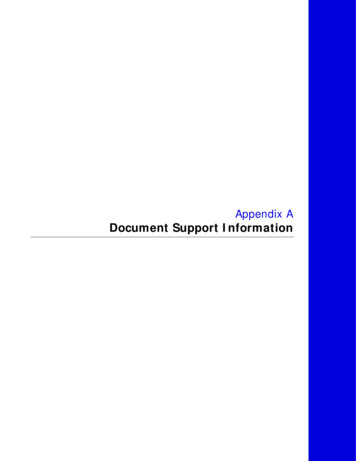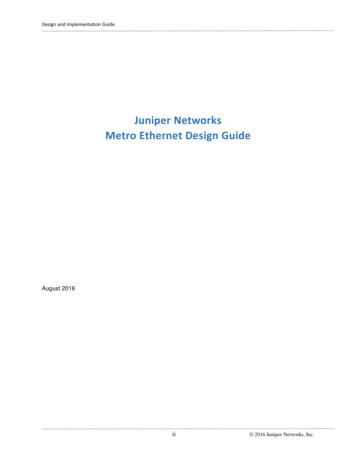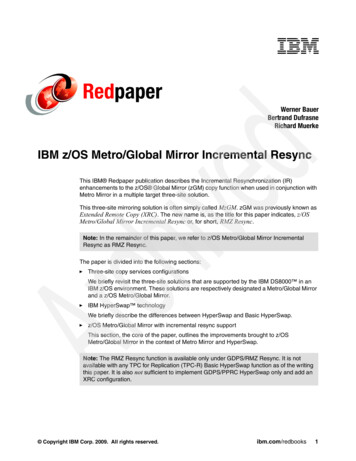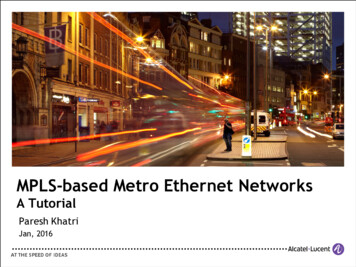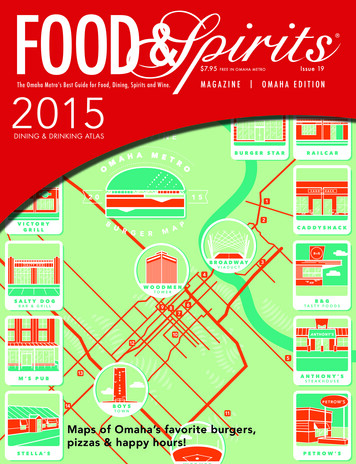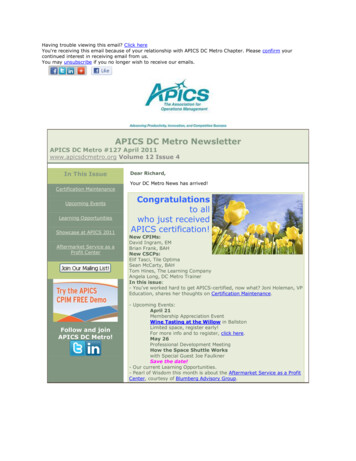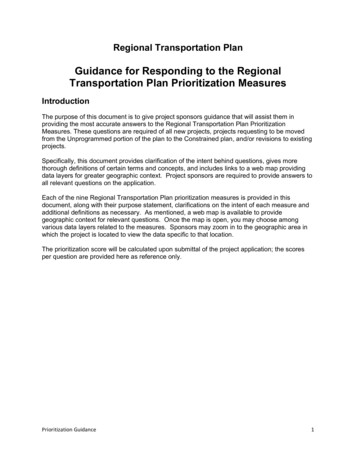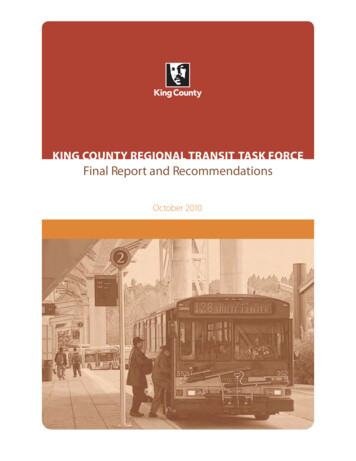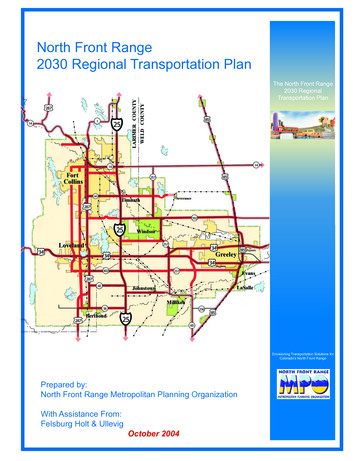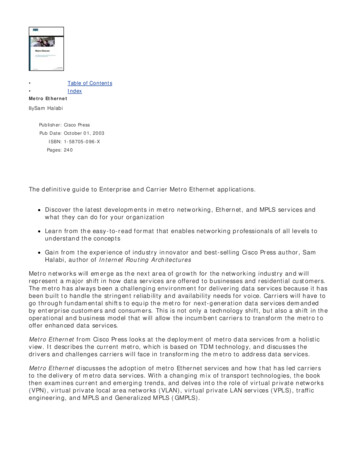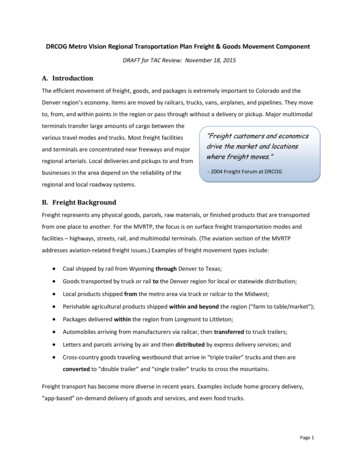
Transcription
DRCOG Metro Vision Regional Transportation Plan Freight & Goods Movement ComponentDRAFT for TAC Review: November 18, 2015A. IntroductionThe efficient movement of freight, goods, and packages is extremely important to Colorado and theDenver region’s economy. Items are moved by railcars, trucks, vans, airplanes, and pipelines. They moveto, from, and within points in the region or pass through without a delivery or pickup. Major multimodalterminals transfer large amounts of cargo between thevarious travel modes and trucks. Most freight facilitiesand terminals are concentrated near freeways and majorregional arterials. Local deliveries and pickups to and frombusinesses in the area depend on the reliability of the“Freight customers and economicsdrive the market and locationswhere freight moves.”- 2004 Freight Forum at DRCOGregional and local roadway systems.B. Freight BackgroundFreight represents any physical goods, parcels, raw materials, or finished products that are transportedfrom one place to another. For the MVRTP, the focus is on surface freight transportation modes andfacilities – highways, streets, rail, and multimodal terminals. (The aviation section of the MVRTPaddresses aviation-related freight issues.) Examples of freight movement types include: Coal shipped by rail from Wyoming through Denver to Texas; Goods transported by truck or rail to the Denver region for local or statewide distribution; Local products shipped from the metro area via truck or railcar to the Midwest; Perishable agricultural products shipped within and beyond the region (“farm to table/market”); Packages delivered within the region from Longmont to Littleton; Automobiles arriving from manufacturers via railcar, then transferred to truck trailers; Letters and parcels arriving by air and then distributed by express delivery services; and Cross-country goods traveling westbound that arrive in “triple trailer” trucks and then areconverted to “double trailer” and “single trailer” trucks to cross the mountains.Freight transport has become more diverse in recent years. Examples include home grocery delivery,“app-based” on-demand delivery of goods and services, and even food trucks.Page 1
Denver is the northern end of the Ports to Plains corridor connecting Colorado to Mexico via Laredo,Texas. This could lead to increasing the Denver region’s role as a distribution center and freightconsolidation point for goods shipped to and from Mexico via I-70, US-40, and US-287.C. MAP-21 Freight Requirements and GuidanceMAP-21 includes a number of provisions to improve the condition and performance of the transportationsystem to enhance the movement of freight and support investment in freight-related surfacetransportation projects.MAP-21 establishes a national freight policy and associated goals ― “to improve the condition andperformance of the national freight network to ensure that the network provides the foundation for theUnited States to compete in the global economy and achieve each [of the following] goals ” ― To invest in infrastructure improvements and implement operational improvements that:oStrengthen the contribution of the national freight network to the economiccompetitiveness of the United States;oReduce congestion, andoIncrease productivity, particularly for domestic industries and businesses thatcreate high value jobs. To improve the safety, security, and resilience of freight transportation; To improve the state of good repair of the national freight network; To use advanced technology to improve the safety and efficiency of the national freightnetwork; To incorporate concepts of performance, innovation, competition, and accountability into theoperation and maintenance of the national freight network; To improve the economic efficiency of the national freight network, and To reduce the environmental impacts of freight movement on the national freight network.MAP-21 also encourages state DOTs to develop a state freight plan. CDOT completed the State HighwayFreight Plan in 2014. It is the first phase of CDOT’s overall multimodal freight planning efforts. Finally,MAP-21 will also require DRCOG, in coordination with CDOT, to develop and report on freight-relatedperformance-based planning targets and measures.DRCOG’s freight planning efforts are also designed to address MAP-21’s transportation planning factors,specifically:Page 2
Planning Factor #1: Support the economic vitality of the metropolitan area, especially byenabling global competitiveness, productivity and efficiency. Planning Factor #4: Increase the accessibility and mobility options available to people and forfreight. Planning Factor #6: Enhance the integration and connectivity of the transportation system,across and between modes, and for people and freight. Planning Factor #7: Promote efficient system management and operation.D. Current Freight Planning Efforts & Stakeholder InputCDOT is developing its state freight plan in two phases. The MAP-21-compliant State Highway FreightPlan completed in 2014 was the first phase. The second phase will develop an integrated freight planthat incorporates rail and aviation freight modes. CDOT has convened a Freight Advisory Council to doso, which includes DRCOG.DRCOG is conducting a commercial vehicle survey to provide data for its regional travel forecastingmodel, FOCUS. The survey is being conducted in partnership with CDOT and other Front Range MPOs toincrease understanding of how commercial vehicles of all types affect travel and traffic patterns in theFront Range.1. Freight Stakeholder InputDRCOG has conducted, hosted, and participated in numerous freight stakeholder activities, events, andorganizations in recent years. Key examples include: Colorado Freight Summit (July 2009) Colorado Freight Summit Roadmap (December 2009) I-70 Mountain Corridor Coalition (ongoing) CDOT MPO Town Halls (May 2014) CDOT Statewide Freight Advisory Council (July, September, and November 2015) Focus group on freight and commercial vehicles within mixed-use communities (September 2015) DRCOG Commercial Vehicle Survey (2015/2016)2. Key Concerns from StakeholdersDRCOG has also received significant feedback from freight stakeholders over the years; this feedbackhas consistently emphasized the following concerns:Page 3
The level of congestion on the road systemslows truck operations and increases thecost of moving freight. Ultimately, theconsumer pays higher prices for goods andservices. (see Figure 1, pg. 6) One impact of increased roadwaycongestion may be more truck traffic on theroads during peak periods with smallerpayloads. Most trucking companies mustmeet customer-required delivery and pickup times. As the speed of traffic slows, more trucksmay be added to the traffic flow to meet the customer schedules. This is because an individualtruck may not be able to make as many deliveries or travel as far during congested periods. Rail freight traffic through the Front Range metropolitan areas is slow and has safety issues atrail-highway crossings. Many of the older roadways present problems in efficiently moving freight. Facilities built in the1950s used design principles for shorter trucks and lower volumes. The design for shoulderswere narrow and for lower volumes at interchanges. Turning radius on the surface streets weretighter for smaller trucks or reduced as lanes added within existing rights-of-way. Many longhaul operations now use two (tandem) or even three (triple) trailer combinations. The turningmovements, especially, take more space than was designed into many existing roads. Many of the bridges cannot handle the larger freight loads. Bridges with weight limits createout-of-direction travel, increasing miles traveled, time consumed and cost to move freight. With increases in overall freight movement and size of truck fleets, many existing connections tomultimodal freight facilities need to be improved. The increase in truck traffic has overloaded the rest area spaces for parking trucks while in-route.Many truckers are stopping anywhere, including the side of the road. According to the Colorado Motor Carriers Association, local governments and freight customerrules affect the times deliveries and pickups can be made. This has an effect on freightoperations by limiting the number of stops a truck can make. It also leads to more trucksoperating during peak periods, increasing the time to complete trips. Both of thesecharacteristics increase the cost to move freight. The latter adds to congestion during the peakperiods. Some of this can be seen as more trucks on the road with partial loads.Page 4
Shortages of qualified commercial vehicle/truck drivers in the labor force. Poor roadway conditions, such as pavement, markings, and others. Another important freight issue is circulation and delivery within transit-oriented developments,traditional neighborhood developments, and other new urban neighborhoods with very narrowstreets.Consistent freight-related themes from the 2014 MPO and Transportation Planning Region (TPR)Telephone Town Halls and TPR meetings included: More work is needed at the regional level to identify freight bottlenecks, factors hinderingfreight movement, and the importance of Freight Corridors to the entire state. Multi-state Freight Corridors are important to the state and regional economies and should beprioritized for improvements. Reliability of freight movement enables many regional businesses to compete in global markets. Many planned highway improvements will benefit the movement of truck freight. Air is vital to regional businesses to bring in shipments of important goods and enable client andemployee travel. TPRs and MPOs could facilitate the creation of more or improved freight multimodal transferpoints (train/truck, truck/train, and truck/plane). Truck freight is very sensitive to consumer demand and economic activities. Mitigation of impacts of freight movement on communities and highways is needed, particularlybecause freight movement is increasing and trucks are getting larger, and hauling heavier loads.3. Other ActivitiesDRCOG also addresses freight in its Congestion Mitigation Program (CMP). For example, the 2012Annual Report on Traffic Congestion in the Denver Region contains a section analyzing the cost ofcongestion to commercial vehicles, mitigation strategies, and other data. It also includes the followingmap (Figure 1) identifying the locations with the highest congestion costs to freight and businesses. Intotal, the cost of congestion delay is more than 1 million a day to commercial vehicles and businessesin the DRCOG region.Page 5
Page 6
E. Freight Network & FacilitiesFreight is transported in the Denver region through an interconnected system served by several majortravel modes, a roadway and railroad system on the ground, and several multimodal transfer facilities.Figure 2 shows the Denver region’s rail, air, and multimodal freight network. The regional freight networkincludes both public (Figure 2) and private facilities; the latter include railroad tracks, loading docks,production warehouses, and other similar components. It is important to remember that every singlestreet is part of the freight network, from long-haul trucking on interstate highways to residentialdeliveries on local streets.From the national perspective, MAP-21 directed US DOT to establish a national freight network consistingof the National Highway System, freight intermodal connectors, and aerotropolis (airport-related)facilities. More specifically, the national freight network will include the Primary Freight Network (PFN),non-PFN portions of the interstate highways system, and critical rural freight corridors. The PFN in turnconsists of the 27,000 highway centerline miles that are most critical to freight movement.In October 2015, US DOT released the draft National Freight Strategic Plan for public and stakeholderreview. The draft plan notes US DOT’s “efforts to incorporate all of the criteria required of the PFN byMAP-21 did not yield a network that could comprehensively represent the most critical elements of [the]national freight system ” For this reason, the draft plan identifies a proposed national MultimodalFreight Network (MFN) consisting of the highest volume freight routes and facilities for highways,railroads, airports, waterways, and pipelines. An interactive map of the proposed PFN is accessible here:www.transportation.gov/freight/MFN.In the DRCOG region, the proposed MFNDraft MultimodalFreight Networkincludes the interstate highways, Pena Boulevardand Denver International Airport, and portions ofUS-85, US-6, US-36, and E-470. It also includesthe multimodal freight facilities and terminalsand the portions of arterial roadways thatconnect to them, such as 80thAvenue, BrightonRoad, 88th Avenue, Pecos Street, and Broadway.Finally, it also includes portions of East 6thHighwaysRailroadsAvenue in Aurora and Lincoln Road in Lone Tree.Page 7
CDOT’s 2015 State Highway Freight Plan also designates specific freight corridors based on a range ofinputs, including truck traffic, connectivity, federal requirements, stakeholder input, and others. In theDRCOG region, CDOT’s freight corridors include interstate highways, freeways, and a few major regionalarterials, such as US-287, SH-119, and South Santa Fe Drive.CDOT also developed the State Freight and Passenger Rail Plan in 2012 to meet the requirements of thefederal Passenger Rail Improvement and Investment Act of 2008. The plan’s purpose is to “provide aframework for future freight and passenger rail planning in Colorado” and “to move freight railtransportation forward with a focus on economic development, as well as set the stage for the state totake advantage of the momentum around the country in regard to the interest in expanding passengerrail service.” The plan also created and adopted a vision and several goals addressing the state’s freightand passenger rail system. Finally, policy recommendations and short and long term illustrative railsystem improvement needs were also identified in the plan.Page 8
Page 9
1. Trucks/RoadwaysThe majority of freight movement in the Denverregion occurs via commercial vehicles such as trucksand vans across the entire roadway system. Trucksare generally classified as a vehicle with a grossweight greater than 10,000 pounds. For example, aFord F350 pickup marks the bottom end of theweight threshold.The MVRTP’s 2040 fiscally constrained regional roadway system includes 8,300 lane miles of freeways,tollways, major regional arterials, and principal arterials that serve many of the major freight origin anddestination locations. Thousands of additional miles of local roadways provide direct access to theremaining locations. A few roadways are also designated as National Highway System Connectors. Theyare noted on Figure 8 and provide connections to major multimodal terminals such as airports, railterminals, truck terminals, pipeline terminals, Park-n-Ride lots, bus terminals, and bus stations.Regulatory and other issues facing truck movements include: CDOT regulations and rules for longer combination vehicles (LCVs), trucks that pull more thanone trailer; Local regulations regarding the time of day that trucks can make deliveries and pickups; Weight and winter chain law restrictions on roadways; Upgrading the port of entry into Denver to include “smart” technologies for electroniccredential checking and weigh-in-motion facilities; Increased homeland security concerns—criminal background checks, facility security plans,updating of hazardous material placards ontrucks; Bridge clearance and associated laneweaving; Emergency response to truck crashes; and Rest stops, truck stops and parking.One important but often overlooked regulatory aspect is the conflict between federal “work shift”requirements (the maximum length of a work shift) and CDOT road closures. For example, if CDOT has aPage 10DRAFT
wintertime closure in the I-70 mountain corridor, a long-haul trucker cannot extend his work shift toaccommodate the time delay from that closure. This type of situation has incident managementimplications – one illustration of the interconnectedness of the various facets of freight movement.2. Commercial Vehicle VolumesFigures 3 and 4 show 2014 and 2040 forecasted commercial vehicle volumes on the region’s majorroadways and highways. These data are from DRCOG’s 2014 Annual Report on Traffic Congestion in theDenver Region. As expected, the region’s interstates and freeways have the highest volumes ofcommercial vehicles, though portions of roadways such as South Santa Fe Drive, Parker Road, andWadsworth Boulevard also have high commercial vehicle volumes. Additionally, relatively lower volumeroadways, such as interstates in rural areas, may have a high percentage of commercial vehicle traffic.Package Delivery – from Seller to BuyerOne key way commercial vehicles affect our daily lives is in thedelivery of packages. The accompanying graphics illustrate typicalupdates offered to consumers to track the delivery status of theirpackages. From a goods movement perspective, it is interesting tonote how many places a package is transferred to and what modesit may have traveled to reach the consumer. For example, bothpackages originated in the Midwest and were routed through acarrier facility in Hodgkins, Illinois (suburban Chicago) and thenwere likely shipped by truck to a distribution center in CommerceCity based on the 1.5 days of transit time. Both packages were thensorted and routed very early the next morning for delivery laterthat day. This illustrates the multimodal nature of goodsmovement, logistical complexities, and the importance of reliabletravel and delivery times.Page 11DRAFT
Page 12DRAFT
Page 13DRAFT
3. Crash/SafetyDuring the most recent three-year period available (2010-2012), there were 6,800 crashes involvingtrucks in the Denver region, resulting in 159 serious injuries and 34 fatalities (Table 1). Truck-involvedcrashes made up about four percent of all crashes and three percent of serious injuries, but sevenpercent of all fatalities. Between 2010and 2012, truck-involved crashesincreased nine percent, while totalcrashes increased only three percent.Serious injuries in truck-involvedcrashes increased 68 percent, whiletotal serious injuries increased ninepercent. Finally, between 2010 and2012, fatalities in truck-involved crashesdecreased 23 percent compared to a sixpercent increase in total fatalities. It isimportant to note crash-related statistics can vary considerably from year to year, and comparing truckinvolved crash trends can be difficult because they make up such a small proportion of total crashes.Table 1: Comparison of Truck and Total Crashes (2010-2012)Total CrashesSerious InjuriesFatalitiesNumber Percent Number Percent Number PercentTrucksAll Vehicles6,800176,3004%1605,0003%357%500Page 14DRAFT
Crashes at railroad crossings are also an important issue. Figure 5 shows the number of railroad crossingcrashes statewide from 2005-2014 based on data from the Federal Railroad Administration’s Office ofSafety Analysis. As shown, the number of crashes has been decreasing significantly. Though the FRA datadoes not break out fatalities or injuries, it does include other interesting information. For example, forthe most recent four year period (2011-2014), automobiles were the largest single category (35 percent)of total crashes at crossings. The BNSF Railway had the highest proportion of crashes (44 percent); RTDrail lines were involved in a single crash during the four-year period.Figure 5: Colorado Railroad Crossing Crashes (2005-2014)Page 15DRAFT
4. Freight RailroadsRailroad cars carry the most ton-miles of freight in the Denver region. Railroads generally carry heavyand bulky cargo of lesser value per unit of weight. Freight that is hauled by rail instead of trucks causesless damage to the roadway infrastructure. Figure 6 (FHWA) illustrates freight flows by highways,railroads, and waterways for 2010. While Colorado is an important state for connecting long-haul freightshipping, the relative volume of freight passing through the state is less compared with adjacent states.Figure 6: 2010 Freight Flows by Highway, Railroad, and WaterwayFreight rail traffic in the Denver metropolitan region is dominated by two Class I railroads: Union Pacific(UP) and Burlington Northern Santa Fe (BNSF). Class I railroads are the largest carriers and aredesignated as such by the Surface Transportation Board of the U.S. Department of Transportation. TwoClass III railroads also operate within the Denver region: Denver Rock Island Railroad (DRIR) and GreatWestern Railway of Colorado (GWR). Active rail lines in the region are illustrated in Figure 8 along withswitching yards, multimodal terminals, and major transfer facilities.Page 16DRAFT
The BNSF railroad’s principal line through the Denver region runs north-south carrying the majority oftrains from Wyoming to Texas. Its principal cargo is coal. The BNSF operates four branch lines within theregion: Golden to Denver, Broomfield-Lafayette, Longmont-Barnett, and a line connecting Denver,northeastern Colorado, and Nebraska to the northeast.The UP operates major north-south lines and east-westlines within the region. The north-south line connectsDenver with Cheyenne and Pueblo. East-west linesconnect Denver with Utah and western Colorado toKansas. RTD purchased from UP the 33-mile branch lineconnecting Commerce City to the Boulder area. It is activeonly from Commerce City to just north of 120th Avenue.The BNSF and UP have joint operations and track sharing agreements south of downtown Denver. The jointline is known as the Consolidated Mainline. It is operated as a paired track; one track used for northboundtraffic and the other track used for southbound traffic.The DRIR has a switching and terminal spur line north of I-25 and 58th Avenue running roughly parallel toI-270 connecting the UP and BNSF facilities. The GWR operates branch lines connecting North Front Rangecommunities such as Fort Collins and Loveland to Longmont. GWR has an interchange point with BNSF atLongmont (switching only).5. Major Multimodal TerminalsFigure 2 shows the location of the current UP and BNSF multimodal rail-truck transfer facilities. They arealso listed in Table 2 below. The BNSF operates the Rennicks and Globeville (31st Street) switching yards.BNSF has major terminals and freight transfer facilities to serve trailers on flat cars (TOFCs) and autotransport. UP has major terminals and freight transfer facilities known as the North Yard, 40th StreetYard, Rolla Auto Transfer Yard, and Pullman Yard, in addition to several switching yards. The NationalHighway System also includes the following intermodal connectors in the Denver region: RTD Transit Stations: Broadway LRT station, Broomfield Park-n-Ride, Civic Center Station,Denver Union Station (Amtrak), Southmoor Park-n-Ride, Stapleton (now Central Park) Parkn-Ride, Table Mesa Park-n-Ride, Thornton Park-n-Ride, Wagon Road Park-n-Ride, andWestminster Center Park-n-RidePage 17DRAFT
Railroad Facilities: Burlington Northern Railroad Auto/Railroad Transfer Facilities, SouthernPacific Railroad Transfer Facility, Union Pacific Railroad Auto/Railroad Transfer Facilities Pipeline Facilities: Conoco Pipeline Transfer, Kaneb Pipeline Transfer, Phillips Pipeline, TotalPetroleum Pipeline Terminal Other Facilities: Denver International Airport, Denver Greyhound Bus StationTable 2: Existing Multimodal Freight FacilitiesNameConoco Pipeline TransferKanab Pipeline TransferBNSF Rennicks YardstBNSF 31 St. YardLocationType56th Ave. and Brighton Rd.th80 Ave. and W. of SH-2rd53 Ave. and Bannock St.thPipeline TerminalPipeline TerminalRail YardGlobeville Rd. and 38 St.Rail YardUP Burham (4 Ave.) Yard800 Seminole Rd.Rail YardUP MonacoSmith Rd. and Monaco Pkwy. Rail YardUP RoydaleSmith Rd. and Peoria St.Rail YardUP 36th St. YardWazee St.Rail YardBNSF Big LiftSH-85 and Louviers Ave.Rail-Truck Transfer FacilitythUP North YardBNSF TOFC YardUP Rolla Auto TransferthUP 40 St. YardBNSF Irondale Auto Transferth901 W. 48 Ave.Rail-Truck Transfer FacilitythPecos St. and 56 Ave.thRail-Truck Transfer Facility96 Ave. and US-85Rail-Truck Transfer Facility40th Ave. and York St.Rail-Truck Transfer FacilitythSH-2 and 88 Ave.Rail-Truck Transfer FacilitythUP Pullman YardBNSF Locomotive ShopsN. of 40 Ave. and SE ofBrighton Blvd.Park Ave., Delgany, and S.Platte RiverRail-Truck Transfer FacilityRail-Truck Transfer FacilityThe appendix contains two “concept examples” of aerial photographs showing multimodal terminalsand the major roadway connectors providing access to them. These examples illustrate where thesemultimodal terminals are located in relation to the region’s multimodal transportation network.6. Air CargoAir cargo activity to and from Denver has grown dramatically over the past 25 years. According to DIA’sMaster Plan, total cargo volume is forecast to increase from approximately 310,800 tons in 2006 toapproximately 714,000 tons by 2030. The number of all-cargo aircraft operations is forecast to increasePage 18DRAFT
from about 21,000 in 2006 to about 40,000 in 2030. Air freight is by nature high value and time sensitiveand is linked to the types of retail, service, and manufacturing businesses expected to lead the region’seconomic development in the future. DIA handles thousands of packages and containers per day, withmuch smaller levels at Centennial, Rocky Mountain Metropolitan, and Front Range Airports. The aviationsection contains more detailed information about the region’s airport operations and future implications.7. PipelinesPipelines in the Denver region ship in oil products and natural gas. Crude oil is processed into usable fuelssuch as gasoline and delivered by truck to filling stations. Colorado’s only oil refinery is located inCommerce City near I-270. Natural gas is used to generate electricity for homes (heating and cooking)and businesses. Colorado requires investor-owned utilities to obtain 30 percent of their electricity fromrenewable sources. Pipeline transfer facilities are shown in Figure 2.8. At-Grade Arterial Railroad CrossingsOver 500 at-grade intersections exist between the rail system and the roadway system in the Denvermetropolitan region. Many of these at-grade crossings are found north of the I-70 corridor inpredominately industrial and warehouse areas. At-grade crossings can pose safety concerns as well asproblems of delay to auto and truck traffic and emergency services. The 58 rail-on-roadway crossings onthe regional highway network are shown in Figure 7.The number of trains that cross a road per day will increase on those lines that may serve commuter railin the future. Corridor studies will determine the need for constructing additional grade-separations atsuch locations. In recent years, the region has converted several at-grade crossings into grade-separatedones, such as the UP at Wadsworth Bypass/Grandview Avenue, the UP At Pecos Street, the UP/RTD EastRail at Peoria Street, and others.9. WarehousingThe Denver region is the hub of the state for warehousing and distribution activities. National QuarterlyCensus of Employment and Wages (QCEW) data shows almost 3,000 firms (with at least 10 employees)are engaged in wholesale trade and warehousing activities in the Denver region. Figure 8 shows thelocations and concentrations of wholesale trade and warehousing firms in the Denver region based onthe same data, which uses national NAICS employment category codes.Page 19DRAFT
Page 20DRAFT
Page 21DRAFT
10. Hazardous MaterialsCDOT is responsible for designating hazardous materials (hazmat) routes based on several criteria andpolicy directives, such as Title 42, Article 20 of the Colorado Revised Statutes and CDOT Policy Directives1903 and 1903.1. In practical terms, CDOT’s Hazmat Advisory Team analyzes whether a proposed routemeets several criteria. If so, the Transportation Commission must approve the proposed designation,and then CDOT files a petition with the Colorado State Patrol for final approval. The 12 required criteriaconsider connectivity, interstate commerce, traffic volumes, safety, surrounding land uses and otherfactors (see here for more information).Figure 9 shows CDOT’sFigure 9: Designated Hazmat & Nuclear Materials Routesgraphical representation ofhazmat and nuclear materialsroutes in the DRCOG region.Hazmat RoutesHazmat/NuclearMaterials RoutesRoadways shown in greenare designated hazmat andnuclear materials routes;those in red are hazmatroutes only. The starsindicate municipalities thatrequire gasoline, diesel, andliquefied petroleum gas tocomply with routingrequirements. Designatedroutes in the Denver regioninclude interstates andportions of US-36, US-85,US-285, C-470, SH-119, andSH-52.Page 22DRAFT
F. Key Freight Commodity Flow DataCDOT prepared commodity flow data profilesFigure 10: CDOT Freight Zone #3identifying the top commodities transported bytruck into and out of 14 “economic regions” inColorado. CDOT identifies the Denver economicregion as Freight Zone #3 (Figure 10), whichcorresponds to DRCOG’s planning area except forexcluding southwest Weld County. However,additional data for Weld County is included wherefeasible. According to CDOT’s State Highway FreightPlan, oil and gas activity is heavily concentrated inWeld County, with over 21,000 active wells(40 percent of the statewide total). Besides oil and gas, agriculture is a principal industry in Weld County.CDOT used the IHS Global Insight, Inc. Transearch 2010 database, consistent with the State HighwayFreight Plan, to prepare the commodity flow analysis which focuses on the top commodities transportedby truck by weight in class for 2010 and forecast for 2040. The Transearch database combines theprimary shipment data obtained from many of
operation and maintenance of the national freight network; To improve the economic efficiency of the national freight network, and To reduce the environmental impacts of freight movement on the national freight network. MAP-21 also encourages state DOTs to develop a state freight plan. CDOT completed the State Highway Freight Plan in 2014.
